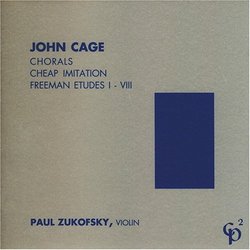| All Artists: John [1] Cage Title: John Cage: Chorals; Cheap Imitation; Freeman Etudes I-VIII Members Wishing: 1 Total Copies: 0 Label: Cp2 Records Release Date: 12/12/1995 Genre: Classical Styles: Chamber Music, Forms & Genres, Short Forms, Instruments, Keyboard, Strings Number of Discs: 1 SwapaCD Credits: 1 UPC: 096661010328 |
Search - John [1] Cage :: John Cage: Chorals; Cheap Imitation; Freeman Etudes I-VIII
 | John [1] Cage John Cage: Chorals; Cheap Imitation; Freeman Etudes I-VIII Genre: Classical
CHORALS The Chorals are an arrangement for violin of one of the Solos for Voice in Songbooks following Paul Zukofsky's suggestion to make a continuous music of disparate elements, single tones, unisons, and beatings. The ... more » |
Larger Image |
CD Details
Synopsis
Album Description
CHORALS The Chorals are an arrangement for violin of one of the Solos for Voice in Songbooks following Paul Zukofsky's suggestion to make a continuous music of disparate elements, single tones, unisons, and beatings. The Solo in Songbooks had been composed by placing a transparent staff of a special design over nine of Erik Satie's posthumously published Douze Chorales. The design of the staff was such as to give equal space for each chromatic tone. Thus its five lines were not equidistant, those representing a minor third being closer together than those representing a major third. "Rubbings" were made. When notes were not in the proper position for naturals, flats, or sharps, they were microtonally between these. For the Chorals the staff is again conventional, and accidentals, flat flats, sharp sharps, sharp flats, flat sharps, flat and sharp naturals are used. Which are single tones, which unisons, and which beatings, was determined by means of I Ching chance operations. CHEAP IMITATION Cheap Imitation for piano solo was written in December 1969 to take the place of the Socrate of Erik Satie as an accompaniment for Second Hand by Merce Cunningham, the right to arrange the Socrate for two pianos having been refused by the French copyright holder. Becoming attached to the imitation as I had for many years been attached to the original, I arranged it for an orchestra of any size between the minimum of twenty-four and the maximum of ninety-five. In 1975 Paul Zukofsky, encouraged by my use in the Etudes Australes of not graphic but relatively conventional notation, asked whether I would consider making a similar work for the violin. I am now engaged in that work. But in order to do it, I study under Zukofsky's patient tutelage, not how to play the violin, but how to become even more baffled by its almost unlimited flexibility. Cheap Imitation for violin solo is one of the results of this study. I wrote the notes. The editing is Zukofsky's, though he did it in my! presence and often asked me which of several possibilities I preferred. The bowing in the third movement was I Ching chance determined. The three movements of the Socrate are Portrait of Socrates, On the Banks of the Ilissus, and Death of Socrates. The following information regarding the compositional means of Cheap Imitation appeared with the version for piano solo. The I Ching (64 related to 7, to 12, etc.) was used to answer the following questions for each phrase (with respect to the melodic line and sometimes the line of accompaniment) of Erik Satie's Socrate: 1. Which of the seven "white note" modes is to be used? 2. Beginning on which of the twelve chromatic notes? Then, in I (for each note excepting repeated notes): 3. Which note of given transposition is to be used? In II and III original interval relations were kept for one-half measure, sometimes (opening measures and subsequent appearances) for one measure. The intonation for the violin is Pythagorean following the definition of this system by Hermann Helmholtz (On the Sensations of Tone, Dover Publications, N.Y., p. 312). Rather than making the Pythagorean comma 24 cents precisely, the violinist should sometimes increase it, even to 40 cents, in order to distinguish tones from one another. The violinist should follow the rule of playing non vibrato but not too strictly. Dotted slurs are phrases, but, unless there is a filled-in slur, every note is to be bowed separately. Asterisks associated with high tones indicate a particularized, even dramatic, pianissimo. Commas associated with filled-in slurs indicated portato, a close togetherness of clearly articulated tones, what might be termed a paradoxical legato or a "philosophical" détaché [reprinted from the preface to the violin solo edition of Cheap Imitation]. FREEMAN ETUDES When

 Track Listings (12) - Disc #1
Track Listings (12) - Disc #1